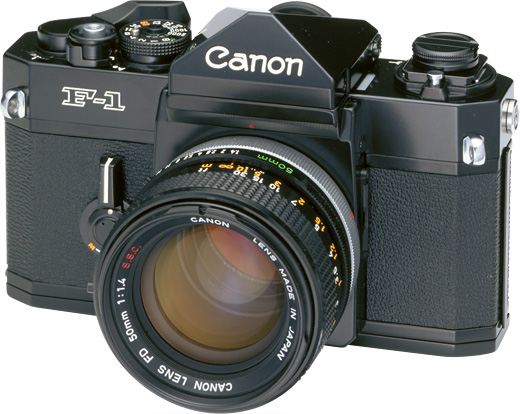
An F-1 with a few improvements. The film advance winding stroke was reduced from 180 to 139. And the film advance lever's ready position was widened from 15 to 30. This made film advance faster. The film advance lever also had a new plastic tip. The film speed range was also increased from ISO 2000 to ISO 3200. The PC terminal had a fastener to prevent the PC cord from disconnection. In all, thirteen improvements over the old F-1 were made.
| Shutter | Four-axis, horizontal-travel focal-plane shutter with metal curtains. X, B, 1, 1/2, 1/4, 1/8, 1/15, 1/30, 1/60, 1/125, 1/250, 1/500, 1/1000, 1/2000 sec. Built-in self-timer (self-timer lever also functions as a stop-down lever). Multiple exposures enabled. |
| Viewfinder | Interchangeable eye-level pentaprism. Split-image rangefinder encircled by microprism rangefinder at center of fresnel matte screen (Type E standard screen). Eight other interchangeable focusing screens optional. Metering indicator, exposure match needle, stopped-down metering needle, shutter speed indicator, overexposure and underexposure warnings, and light window for exposure display provided. |
| - Magnification | 0.77x |
| - Coverage | 97% |
| Power | One 1.35 V HD mercury cell. Battery check provided. |
| Size | 147 x 100 x 50 mm |
| Weight | 845 gr |
Photos tagged for the Canon F-1n (1976) in the Canon Classics Flickr Group.
She's my favorite camera. Who times a F-1 or F-1 n had in hand understands the fascination. It is on one side of a tank and on the other side a precision instrument. Because it works purely mechanically, it does so if necessary even without a battery. The F-1 is very good in the hand, all controls are logically laid out and has a bright viewfinder. It is the most robust camera that I know, it worked at 47 ° C in Twentynine Palms just like at -35 ° C in the ice laboratory, whether 100% humidity in the tropics or in the dusty Sahara. I own three F1n and F1, in some cases for more than 30 years. Meanwhile all cameras got a CLA, new seals and mirror dampers and I've still the same it rebuilt and adjust the meter to 1.5V. Now I can use the successor 625U instead of mercury battery.
It's an awesome piece of metal. I have the PJ screen in it which I just love. Love the partial metering so much more the centre weighted... I actually know what its exposing for. Love the J screen, so bright and clear. There's really no going back. Which is a pain because theres a few gotchas. Like, um... why, why WHY is there no Shutter Priority unless you attach a bulky winder to it? Is there a single good reason for this?? I really miss that feature because I'm not a big fan of Aperture Priority. Theres also no exposure lock. That's also dumb. I guess at heart it's really an all manual camera, and if you use it as such its simply the best. I've not used the winders but I understand you can't take them on or off with film loaded which also seems like a pretty poor design too...
As a pro with 30 years experience with dozens of cameras I can state with confidence this is my favorite 35mm film camera of all time. It feel good in the hand, solid! bright accurate finders and durable shutter. Did I say durable? I have used them in the rain, snow, mud and studio every day for 20 years and NEVER a camera failure. I did have the motor drive go out on one, though. I love the 12% metering pattern and the available different focusing screens. Mirror lock up is a feature I use alot. No battery needed to operate this true "Brass and Glass" classic. The battery just runs the meter and there are replacements to the mercury battery that was originally designed for it. I knocked off 0.5 in the rating because of the battery otherwise this camera is a ten all the way. Although I shoot digital cameras now for my work, I still have and use my F-1n. I will continue to shoot with it as long as film is available.
Only one thing to add to the above camera description: the battery check /on/off switch was changed such that it was spring loaded in the "check" position to avoid inadvertent battery drain.
The Canon F-1 is the ultimate workhorse. I put hundreds of rolls of film through mine and they never once let me down. The meter is extremely accurate, and the 12% selective area metering pattern is great for shooting narrow latitude slide film.
For me, the fact that the original F-1 had mirror lock-up was a big deal -- enough of one that I bought used Original F-1s instead of new New F-1s back in the 1980s. I used mirror lock-up quite a bit when doing high magnification and long-telephoto photography.